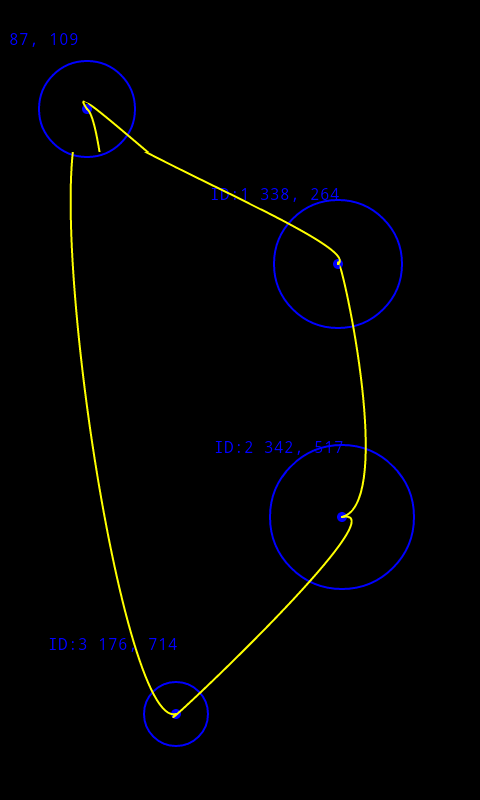Android Adventures part 7.5 : More multi-touch in Processing
Back to part 7…, on to Part 8…

Example sketch made with this code.
Based on my previous post (part 7), I wanted to advance the capabilities of multitouch in Processing a bit more. The previous example was fairly primitive, but got the job done. However, it had a few shortcomings:
- The drawing of graphics was happening in the surfaceTouchEvent() function, rather than Processing draw() function. This caused a bit of flickering on screen, and made it hard to screengrab stuff from the Davlik Debug Monitor.
- It only tracked the current position; it stored no historical data. What if you wanted to track the previous frames position for a certain touch point to generate a motion vector?
With a bit of work I came up with the below code. It is a snapshot of only the code that is needed to enable more robust multitouch querying in your Processing sketch. You’d take over in the draw() function. Quick overview:
- At the top two global variables are defined that store the max number of touch points your phone supports (by trial and error via this code I found that my phone has five), and an array that will store the MultiTouch data. It should be noted that you can set maxTouchEvents to a higher number just to be safe, shouldn’t hurt anything.
- setup() populates the MultiTouch array with new MultiTouch objects. Each object tracks a different touch point.
- draw() then checks for updated (touched) MultiTouch data, and then exposes those objects to you to query. The attributes I gave them mirror how Processing deals with querying mouse positional data: motionX, pmotionX, motionY, pmotionY, size, psize, id.
- surfaceTouchEvent() is a function that can be overridden to intercept Androids MotionEvent objects, that store the MultiTouch data in them. That’s what happens below: It updates our MultiTouch array created earlier with any new MultiTouch data whenever the screen has motion applied to it.
- MultiTouch is the class that stores the data extracted from the Android MotionEvent object. One is created per touch point on screen (so if you have five touch points, then you have five of these objects).
Here’s the code:
// multiTouchCore.pde
// Eric Pavey - 2011-01-02
// Code used to get multitouch working in Processing.
// Add to what's in the draw() function to implement the magic.
// It's all about the MotionEvent:
// http://developer.android.com/reference/android/view/MotionEvent.html
//------------------------------
// Setup globals:
// Define max touch events. My phone (seems to) support 5.
int maxTouchEvents = 5;
// This array will hold all of our queryable MultiTouch data:
MultiTouch[] mt;
//------------------------------
void setup() {
// Populate our MultiTouch array that will track all of our touch-points:
mt = new MultiTouch[maxTouchEvents];
for(int i=0; i < maxTouchEvents; i++) {
mt[i] = new MultiTouch();
}
}
//------------------------------
void draw() {
// If the screen is touched, start querying for MultiTouch events:
if (mousePressed == true) {
// ...for each possible touch event...
for(int i=0; i < maxTouchEvents; i++) {
// If that event been touched...
if(mt[i].touched == true) {
// DO SOMETHING WITH IT HERE:
// Amazing mult-touch graphics implemeneted....
}
}
}
}
//------------------------------
// Override parent class's surfaceTouchEvent() method to enable multi-touch.
// This is what grabs the Android multitouch data, and feeds our MultiTouch
// classes. Only executes on touch change (movement across screen, or initial
// touch).
public boolean surfaceTouchEvent(MotionEvent me) {
// Find number of touch points:
int pointers = me.getPointerCount();
// Set all MultiTouch data to "not touched":
for(int i=0; i < maxTouchEvents; i++) {
mt[i].touched = false;
}
// Update MultiTouch that 'is touched':
for(int i=0; i < maxTouchEvents; i++) {
if(i < pointers) {
mt[i].update(me, i);
}
// Update MultiTouch that 'isn't touched':
else {
mt[i].update();
}
}
// If you want the variables for motionX/motionY, mouseX/mouseY etc.
// to work properly, you'll need to call super.surfaceTouchEvent().
return super.surfaceTouchEvent(me);
}
//------------------------------
// Class to store our multitouch data per touch event.
class MultiTouch {
// Public attrs that can be queried for each touch point:
float motionX, motionY;
float pmotionX, pmotionY;
float size, psize;
int id;
boolean touched = false;
// Executed when this index has been touched:
//void update(MotionEvent me, int index, int newId){
void update(MotionEvent me, int index) {
// me : The passed in MotionEvent being queried
// index : the index of the item being queried
// newId : The id of the pressed item.
// Tried querying these via' the 'historical' methods,
// but couldn't get consistent results.
pmotionX = motionX;
pmotionY = motionY;
psize = size;
motionX = me.getX(index);
motionY = me.getY(index);
size = me.getSize(index);
id = me.getPointerId(index);
touched = true;
}
// Executed if this index hasn't been touched:
void update() {
pmotionX = motionX;
pmotionY = motionY;
psize = size;
touched = false;
}
}
Back to part 7…, on to Part 8…